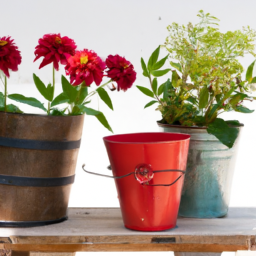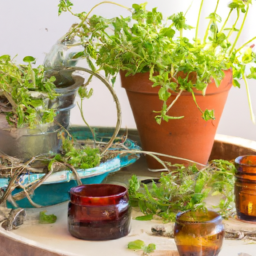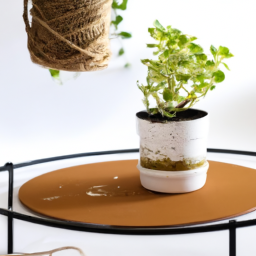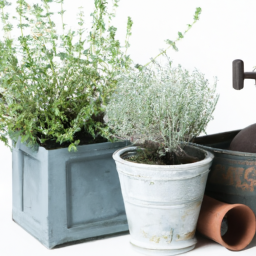
Have you ever looked at a pile of discarded items and wondered if there was a way to give them new life? Well, look no further! In this blog post, we will explore the world of upcycled planters and how they can turn trash into treasures. Upcycling, a term that has gained popularity in recent years, refers to the process of taking old or unwanted materials and transforming them into something useful and beautiful. And what better way to showcase this creative process than by repurposing everyday items into unique planters for your greenery? So, grab your gardening gloves and let’s dive into the world of upcycled planters, where trash truly becomes treasure.
Benefits of Upcycled Planters: Exploring the Environmental and Aesthetic Advantages
Introduction
Upcycling, the process of transforming waste materials into new products of higher value, has gained significant popularity in recent years. One area where upcycling has made a remarkable impact is in the creation of upcycled planters. These unique and creative planters not only add a touch of charm and personality to your garden or indoor space but also offer numerous environmental and aesthetic advantages. In this article, we will delve into the benefits of upcycled planters, highlighting their positive impact on the environment and the visual appeal they bring to any setting.
Environmental Benefits
1.1. Reducing Waste and Landfill Impact
By repurposing items that would otherwise end up in landfills, upcycled planters contribute to waste reduction and help minimize the environmental impact of our consumption habits. Upcycling materials such as old tires, plastic bottles, or wooden pallets not only saves these items from being discarded but also prevents the need for new resources to be extracted or manufactured to produce traditional planters.
1.2. Conserving Resources
Upcycled planters play a vital role in resource conservation. By reusing and transforming existing materials, we reduce the demand for new resources, such as wood or plastic, which require energy-intensive processes to produce. This conservation of resources helps in preserving natural habitats, reducing deforestation, and conserving energy and water resources.
1.3. Promoting Sustainable Gardening
Upcycled planters align perfectly with the principles of sustainable gardening. By using materials that would otherwise be wasted, we promote a more sustainable approach to gardening. Additionally, upcycled planters often encourage the use of organic or natural planting methods, reducing the need for harmful pesticides or synthetic fertilizers, and promoting biodiversity and soil health.
Aesthetic Advantages
2.1. Unique and Personalized Designs
One of the most appealing aspects of upcycled planters is their ability to add a touch of uniqueness and personalization to any space. The wide variety of materials available for upcycling allows for endless creative possibilities. From vintage teapots and tin cans to colorful ceramic tiles or even old furniture, upcycled planters offer a chance to showcase your creativity and create a truly one-of-a-kind garden or indoor display.
2.2. Adding Character and Charm
Upcycled planters have a way of adding character and charm to any setting. Whether you prefer a rustic, bohemian, or modern aesthetic, there is an upcycled planter out there to match your style. The unique textures, colors, and shapes of upcycled materials can create focal points and conversation starters in your garden, patio, or indoor space.
2.3. Cost-Effective Solution
Not only are upcycled planters visually appealing, but they can also save you money. Instead of purchasing expensive planters from stores, you can utilize items you already have or find affordable materials in thrift stores, flea markets, or even your own garage. Upcycling allows you to create stunning planters on a budget, making it an ideal option for those who want to beautify their spaces without breaking the bank.
Conclusion
Upcycled planters offer a multitude of benefits, both for the environment and the aesthetic appeal of your space. By repurposing waste materials, they contribute to waste reduction, resource conservation, and sustainable gardening practices. Additionally, upcycled planters bring uniqueness, character, and charm to any setting, allowing you to create a personalized and visually stunning display. So, the next time you consider adding planters to your garden or indoor space, why not explore the world of upcycled planters and turn trash into treasures?

Creative Upcycled Planter Ideas: Transforming Waste Materials into Unique Garden Decor
Are you looking for creative ways to repurpose waste materials and add a unique touch to your garden? Upcycled planters are the perfect solution! By transforming trash into treasures, you not only reduce waste but also create one-of-a-kind garden decor. In this article, we will explore various upcycled planter ideas that will inspire your creativity and help you contribute to a more sustainable environment.
1. Tin Cans
Tin cans are versatile and readily available, making them an excellent choice for upcycled planters. Start by thoroughly cleaning and removing any labels from the cans. You can then paint them in vibrant colors or leave them as they are for a rustic look. To turn them into planters, drill drainage holes in the bottom to prevent waterlogging. Fill the cans with potting soil and plant your favorite flowers or herbs. Hang them on a fence or arrange them on a windowsill to add a charming touch to your garden.
If you’re feeling adventurous, you can take your tin can planters to the next level by creating a vertical garden. Attach the cans to a wooden pallet or a sturdy frame and arrange them in a grid-like pattern. This unique planter will not only save space but also create a stunning visual display.
Remember to water your tin can planters regularly and ensure they receive adequate sunlight. With proper care, your upcycled tin can planters will thrive and become a conversation starter among your friends and neighbors.
2. Old Tires
Discarded tires are a common sight in landfills, but with a little creativity, they can be transformed into eye-catching planters. Start by cleaning the tires and removing any debris. To prevent water accumulation, drill drainage holes in the bottom. You can then paint the tires in vibrant colors or use stencils to create unique patterns.
When it comes to planting in old tires, you have several options. One popular choice is to stack multiple tires on top of each other, securing them with adhesive or zip ties. Fill each tire with soil and plant flowers, succulents, or even small shrubs. This tiered planter will add height and visual interest to your garden.
If you prefer a more whimsical approach, consider turning a single tire into a hanging planter. Attach sturdy chains or ropes to the tire and hang it from a tree branch or pergola. Fill it with cascading plants or trailing flowers for a stunning display.
3. Wooden Pallets
Wooden pallets are incredibly versatile and can be repurposed into various garden projects, including upcycled planters. Start by disassembling the pallet and selecting the desired sections. Sand down any rough edges and seal the wood with a weatherproof finish to protect it from the elements.
There are several ways to transform wooden pallets into planters. One option is to create a vertical planter by attaching small pots or containers to the pallet boards. Fill each container with soil and plant your favorite flowers or herbs. This vertical planter will add a unique focal point to your garden while maximizing space.
Another idea is to use the pallet as a base for a raised planter bed. Attach additional wooden boards to the sides of the pallet to create depth, and line the inside with landscaping fabric to prevent soil erosion. Fill the planter bed with nutrient-rich soil and plant vegetables or larger plants.
Remember to choose pallets that are free from chemicals or treated with non-toxic substances, especially if you plan to grow edible plants.
By following these step-by-step upcycled planter ideas, you can turn waste materials into unique garden decor. Get creative, explore different materials, and let your imagination run wild. Not only will you create a sustainable and visually appealing garden, but you will also inspire others to think outside the box and repurpose trash into treasures.

DIY Upcycled Planters: Step-by-Step Guide to Turning Trash Items into Stylish Plant Containers
Are you looking for a creative and sustainable way to add some greenery to your home? Upcycled planters are the perfect solution! By repurposing everyday items that would otherwise end up in the trash, you can create unique and stylish plant containers that not only look great but also help the environment. In this step-by-step guide, we will walk you through the process of turning trash items into beautiful upcycled planters.
Step 1: Gather Your Materials
The first step in creating upcycled planters is to gather the necessary materials. Look around your house for items that you no longer use or that are destined for the trash. Some common examples include old tin cans, glass bottles, wooden crates, and even broken ceramic pots. Be creative and think outside the box – almost anything can be transformed into a planter!
Once you have gathered your materials, make sure to clean them thoroughly to remove any dirt or residue. This will ensure that your planters are ready for the next steps.
If you don’t have any suitable items at home, consider visiting thrift stores or flea markets. These places often have a wide selection of inexpensive items that can be repurposed into planters.
Step 2: Prepare Your Containers
Now that you have your materials, it’s time to prepare them for planting. Depending on the item you are using, you may need to make some adjustments to ensure that it is suitable for holding plants.
If you are using a tin can, for example, you will need to create drainage holes at the bottom to prevent water from pooling and causing root rot. Use a hammer and nail to punch several small holes in the bottom of the can.
For glass bottles, you can either leave them as they are or cut off the top to create an open container. If you choose to cut the bottle, make sure to sand down the edges to prevent any injuries.
Wooden crates and ceramic pots usually don’t require any modifications, but you can paint or decorate them to add a personal touch.
Step 3: Choose the Right Plants
Now that your containers are ready, it’s time to choose the right plants to fill them. Consider the size and shape of your upcycled planters when selecting plants. Some plants, like succulents, are well-suited for small containers, while others, like ferns, require larger pots.
Additionally, take into account the lighting conditions in the area where you plan to display your planters. Some plants thrive in direct sunlight, while others prefer shade. Choose plants that will thrive in the specific environment you have in mind.
When planting, make sure to use a high-quality potting mix that provides good drainage. This will help your plants grow healthy and prevent waterlogged soil.
Step 4: Plant and Care for Your Upcycled Planters
Now comes the fun part – planting your upcycled planters! Fill each container with potting mix, leaving enough space for the roots of your chosen plants. Gently remove the plants from their nursery pots and place them into the prepared containers, adding more soil as needed.
After planting, water your new planters thoroughly to help settle the soil and ensure that the plants are well-hydrated. Be mindful not to overwater, as this can lead to root rot. Regularly check the moisture level of the soil and water accordingly.
Depending on the types of plants you have chosen, they may require additional care such as fertilizing, pruning, or repotting as they grow. Research the specific needs of your plants and provide the necessary care to help them thrive.
By following this step-by-step guide, you can easily transform trash items into stylish and eco-friendly plant containers. Not only will you add a touch of green to your home, but you will also contribute to reducing waste and promoting sustainability. Get creative, have fun, and enjoy the process of turning trash into treasures!
Summary Snapshot
Do you ever look at your trash and wonder if there’s a way to give it a new life? Well, look no further because upcycled planters are here to turn your trash into treasures! These creative and eco-friendly planters are a fantastic way to add a unique touch to your garden while also reducing waste. So, let’s dive into the world of upcycling and discover how you can transform everyday items into beautiful planters.
One of the easiest ways to upcycle is by using old containers like tin cans, glass jars, or even plastic bottles. With a little bit of creativity and a touch of paint, you can turn these items into stunning planters that will add a pop of color to your outdoor space. Not only will you save these items from ending up in a landfill, but you’ll also save money by repurposing instead of buying new planters. Plus, it’s a fun and rewarding activity that you can do with your family or friends. So, next time you finish a can of beans or a jar of pasta sauce, think twice before throwing it away – it could be the perfect planter for your favorite herbs or flowers!
Another great way to upcycle and create unique planters is by using old furniture or household items. Have an old wooden chair that’s seen better days? Turn it into a charming planter by removing the seat and replacing it with a pot or a basket. Or how about that vintage suitcase gathering dust in your attic? Give it a new purpose by filling it with soil and turning it into a stylish planter for your balcony or patio. The possibilities are endless when it comes to upcycling, and the best part is that you can let your imagination run wild. So, instead of tossing out those old items, why not give them a second chance and transform them into beautiful planters that will bring life to your garden?
Your Questions Answered. Comprehensive FAQ:
Q1: What are upcycled planters?
A1: Upcycled planters are containers that have been creatively transformed from discarded or unused items into unique and functional vessels for holding plants. Instead of throwing away items like old tires, teapots, or wooden crates, they are repurposed and given a new life as planters.
Q2: Why should I choose upcycled planters?
A2: Choosing upcycled planters is not only an environmentally friendly choice but also a way to add character and creativity to your garden or indoor space. By upcycling items that would otherwise end up in landfills, you contribute to reducing waste and promoting sustainability while showcasing your personal style.
Q3: What materials can be upcycled into planters?
A3: The possibilities for upcycled planters are endless! Common materials include old tires, tin cans, wine bottles, wooden pallets, mason jars, teapots, and even shoes or boots. Essentially, any item that can hold soil and provide drainage can be transformed into a planter with a little imagination and creativity.
Q4: How do I make my own upcycled planters?
A4: Making your own upcycled planters can be a fun and rewarding DIY project. Start by selecting the item you want to upcycle, ensuring it is clean and suitable for holding plants. Then, you can modify or decorate it as desired, such as painting or adding drainage holes. Finally, fill it with suitable soil and choose the perfect plant to showcase in your unique planter.
Q5: Are upcycled planters suitable for all types of plants?
A5: Upcycled planters can be used for a wide variety of plants, but it’s important to consider the specific needs of each plant. Ensure that the planter provides adequate drainage and enough space for the plant’s root system to grow. Some plants may require more depth or specific conditions, so it’s essential to research and choose plants that are suitable for the planter you have upcycled.

Lisa Chen is a seasoned indoor gardening expert and the author of several bestselling books on the topic. With a background in horticulture and urban farming, Lisa is dedicated to helping urban dwellers embrace the joys of cultivating green spaces indoors. Her detailed guides and hands-on tips empower readers to transform their living spaces into thriving plant sanctuaries.


